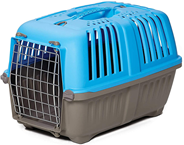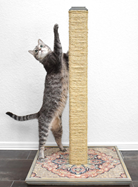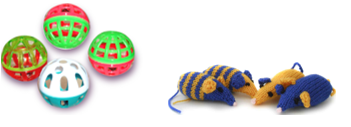Essential Items to Purchase When Adopting a Cat
14 December 2020
Bringing a cat home is incredibly exciting. Although cat's can bring happiness, companionship and lots of laughs, they demand attention and require routines. You’ll have to prepare your home with the essentials to make your home the "purrfect" fit for your new feline friend. If you are unsure of what to buy for your new pet, Cat Protection will talk you through the basic essentials to help make your new cat comfortable and content.
1# - PET CARRIER
Purchase a lightweight Pet Carrier to improve mobility and to transport the new kitten to their home safely. Using a laundry basket or a pillowcase is not safe and can injure or traumatize your kitten. Similarly, using a cardboard box reduces air ventilation and presents a risk of the cat escaping through clawing. Instead, it is recommended to use a simple and sturdy plastic Pet Carrier with a locking door on the front to transport the kitten in a safe manner.
There are important attributes to consider when purchasing a Pet Carrier:
- Includes a removable mesh door, so there is plenty of ventilation for the kitten and the kitten can be taken in or out of the carrier easily
- Made of a rigid and sturdy exterior, especially if you are adopting an older/ heavier cat
- Must be big enough to provide adequate space for the kitten to manoeuvre and be comfortable during the travel
- Contain a machine washable mat is comfy to sit on to reduce the cat's stress
- Per Carrier is compact and can fold away to fit into small spaces (i.e. in a shed, storage area, under the bed, etc) to maintain great condition.

2# - FOOD BOWLS AND WATER BOWLS
Your kitten should have one food bowl and one water bowl upon arrival. The bowls must be easy to clean and should be weighted to avoid tipping. If you've adopted a cat, consider purchasing smaller and shallow bowls designed specifically for kittens. There are best practises relating to the management of the bowls as outlined below:
- Bowls should be cleaned daily and placed far from the litter box, as cats do not like to eat and relieve themselves in the same location. This can confuse them of whether they should eat or use the restroom, throwing them off their usual patterns. Additionally, litter particles may end up on the food which can cause the cat to become ill.
- Remember to place your food and water bowl away from each other to avoid cross contamination. Cat's do not enjoy the scent of food while drinking water.
- Choose a calm or quiet location such as a bathroom or hallway to allow the cat to relax and eat in peace. Cats are creatures of habit, so once you select a location, keep it permanent. This will reduce confusion and is less likely to disrupt their regular eating and drinking schedules.
- Try to avoid busy locations such as kitchens as common activity can cause stress on the kitten and force them to eat quickly. The commotion can make the kitten feel nervous about eating or someone can accidently step on their tail.
- Provide separate food bowls for each kitten to prevent them from eating too quickly and guarding the bowl and creating cat fights.

3# - TYPE OF FOOD
Fundamentally, there are several types of food and the choice is determined by the age and size of your feline friend. For example, kittens need a special diet, while senior cats may require a diet formulated especially for seniors. It is recommended to consult with the shelter or pet store regarding the diet of the kitten to ensure a consistent diet for a while. Keeping her diet the same will be a comfort, as she is trying to adjust to her new home.
4# - COMFY BED
The bed should be warm and soft, and it should be located in a quiet place that makes your kitty feel comfortable and safe. The choice can be between a bed with a roof or open style. Whatever the choice, they need to be large enough for your cat to lay down and stretch but small enough to help the kitten feel secure. It is important to purchase a bed that is easily cleaned and regularly washed to maintain great hygiene.

5# - LITTER BOX
A litter tray is a rectangular container filled with a loose granular material known as cat litter inside, that cat's can use as a restroom. This should be placed in a quiet, accessible location; one box per floor is recommended in a multi-level home. Avoid moving the box unless absolutely necessary. Keep in mind that cats will not use a messy or smelly litter box, so scoop solid wastes out of the box at least once a day. Wash the litter box with a mild detergent and refill at least once a week. There are several styles of litter box to choose from.
- A self-cleaning litter box has a mechanism that rakes the dirty litter after your cat has used the box. However, they are relatively expensive, and the mechanism can frighten cat's.
- A hooded litter box has a tall cover designed to give the kitten privacy and reduce litter being tossed onto the floor. However, some cats are afraid of the hood and will not use the litter box.
- The third option is a plastic and rectangular box containing litter. Many cat owners prefer this simple option for their kitten to use as a restroom.

6# - ACCESS TO A HIGH SPOT WHERE THEY CAN VIEW THEIR SURROUNDINGS
Cats are happiest when they have high spots to lounge, as it helps to reduce stress and keep your cat relaxed. There are four ways to provide high resting places in your home:
- Provide an open pathway leading to high cupboards, with no clutter and adequate space for the kitten to lie down.
- Provide high empty shelves with a towel
- Allow your kitten to rest on tables and on the back of high couches in your living room
- Simple cardboard boxes should do the trick
7# - A STURDY SCRATCHNIG POST
Cat's need to scratch! When a kitten scratches, it relieves the urge and their claws get smoother. This keeps them relatively blunt and less likely to harm both humans and furniture. Provide your cat with a sturdy scratching post, at least three feet high. The post should be stable enough, so it won't wobble during use or topple over.

8# - CAT TOYS
Provide your cat with a variety of safe toys. Pouncing is a favourite activity of kittens, so balls and catnip-filled mice are good options. To avoid the danger of choking, do not give toys with small parts that can easily be torn off, such as bells, feathers, or pom-poms.

9# - COLLAR & ID TAG
Your feline friend should wear a safety collar and an ID tag at all times:
- It is recommended the collar has an automatic release that will unfasten if your cat gets stuck on something, like a tree branch. Make sure the collar fits properly and won't irritate the neck or affect the breathing or swallowing of your kitten. A general rule is to allow two fingers to fit between the collar and the neck.
- The ID tag should contain your name, address, and telephone number to notify the owner if a lost cat is found.
- Cats Protection will implement a microchip inside the kitten before he or she is adopted to ensure the safety. Should the kitten get lost, you can trust our team to locate the kitten via the implanted microchip and return your kitten safely.
10# - A GROOMING BRUSH
Although cat's groom themselves, you should brush or comb regularly especially if your cat has medium to long fur. Frequent brushing includes improving muscle tone and stimulates the skin to produce natural oils that give their coat a healthy shine. It also reduces shedding and the incidence of hairballs.
 Remember: When providing beds, litter trays, scratching posts and food and water bowls, it is a good idea to provide one extra. When more than one cat is sharing the home, provide one of these items per cat plus one extra. For example, two cats should have access to at least three litter trays.
Remember: When providing beds, litter trays, scratching posts and food and water bowls, it is a good idea to provide one extra. When more than one cat is sharing the home, provide one of these items per cat plus one extra. For example, two cats should have access to at least three litter trays.
By Forida